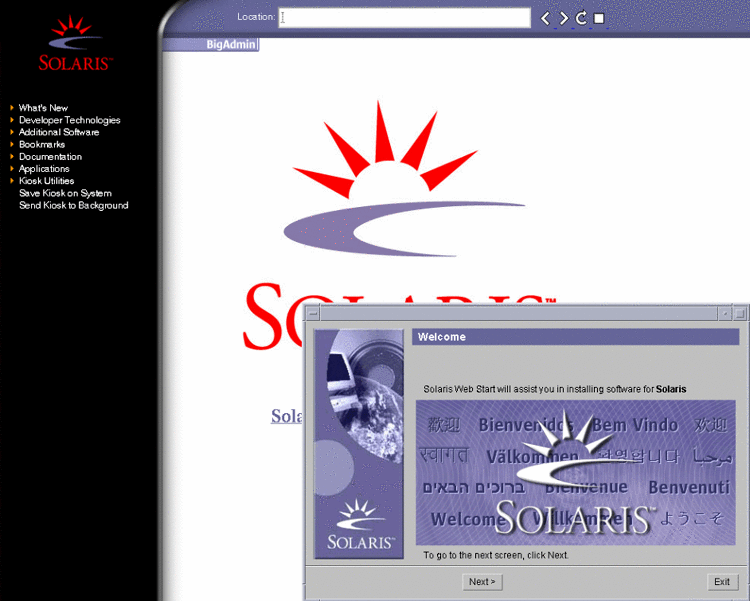SPARC: To Perform an Installation or Upgrade With the Solaris Web Start Program
-
Decide if you want to install the software by using the DVD-ROM or CD-ROM drive or by using a net image.
-
If you're using a DVD-ROM or CD-ROM drive, insert the Solaris SPARC Platform Edition DVD or Solaris SPARC Platform Edition Installation CD.
-
If you're using a net installation image, change directories to where the installation media is located. You might need to contact your network administrator for the location. For more information on installing from the network, see Chapter 11, Preparing to Install From the Network With DVD Media (Tasks) or Chapter 12, Preparing to Install From the Network With CD Media (Tasks).
-
-
Boot the system.
-
If the system is new, out-of-the-box, turn on the system.
-
If you want to install or upgrade an existing system, shut down the system.
-
To boot from the local DVD or CD, type the following command.
ok boot cdrom [[- nowin]]
-
To boot from an install server on a network, type the following command.
ok boot net [[- nowin]]
-
- nowin
-
Specifies to run the Solaris Web Start program in CLI mode.
The Solaris Web Start installation begins.
-
-
If you are prompted, answer the system configuration questions.
-
If you preconfigured all of the system configuration information, the Solaris Web Start program does not prompt you to enter any configuration information.
-
If you did not preconfigure the system configuration information, use the Worksheet for Installation or the Worksheet for Upgrading to help you answer the system configuration questions.
If you are using the GUI, after you confirm the system configuration information, the Solaris Web Start Installation Kiosk and Welcome to Solaris dialog box appear. If your system has insufficient memory, the Kiosk does not display.
Figure 14–1 Solaris Web Start Kiosk Menu

You can click on any link in the Kiosk menu.
Note –In some situations, the Kiosk might cover a dialog box. To display a hidden dialog box, from the Kiosk menu, choose Send Kiosk to Background.
The Installer Questions screen appears.
-
-
Decide if you want to reboot the system automatically and if you want to automatically eject the disc. Click NEXT.
The Specify Media screen appears.
-
Specify the media you are using to install.
-
If you are installing a Solaris Flash archive, continue.
-
If you are not installing a Solaris Flash archive, proceed to Step 6.
-
Type the information that you are prompted to enter.
Media Selected
Prompt
DVD or CD
Insert the disc where the Solaris Flash archive is located.
Network File System
Specify the path to the network file system where the Solaris Flash archive is located. You can also specify the archive file name.
HTTP
Specify the URL and proxy information that is needed to access the Solaris Flash archive.
FTP
Specify the FTP server and the path to the Solaris Flash archive. Specify the user and password information that allows you access to the FTP server. Specify any proxy information that is needed to access the FTP server.
Local tape
Specify the local tape device and the position on the tape where the Solaris Flash archive is located.
If you selected to install an archive from a DVD, CD, or from an NFS server, the Select Flash Archives panel is displayed.
-
For archives that are stored on a disc or an NFS server, on the Select Flash Archives panel, select one or more Solaris Flash archives to install.
-
On the Flash Archives Summary panel, confirm the selected archives and click Next.
-
On the Additional Flash Archives panel, you can install an additional Solaris Flash archive by specifying the media where the other archive is located. If you do not want to install additional archives, select None and click Next to continue the installation. Proceed to Step 7.
-
-
Decide if you want to perform an initial installation or an upgrade.
The Solaris Web Start program determines if the system can be upgraded. You must have an existing Solaris root (/) file system. If you are upgrading by using the Solaris Installation CD, you must have a 512–Mbyte slice. The Solaris Web Start program detects the necessary conditions and then upgrades the system.
-
Follow the instructions on the screen to install the Solaris software. If you are NOT installing a Solaris Flash archive, you can also install additional software.
When the Solaris Web Start program finishes installing the Solaris software, the system reboots automatically or prompts you to reboot manually.
After the installation is finished, installation logs are saved in a file. You can find the installation logs in the following directories:
-
/var/sadm/system/logs
-
/var/sadm/install/logs
-
-
If you are upgrading the Solaris software, you might need to correct some local modifications that were not preserved. For detailed instructions, refer to To Correct Local Modifications After Upgrading.
- © 2010, Oracle Corporation and/or its affiliates
